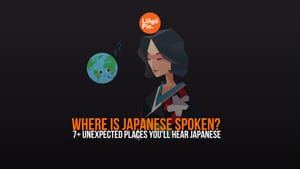So, you want to learn Japanese with music. Great idea! This is a very effective, fun, and immersive method of language learning.
By listening to Fuji Kaze and other Japanese artists, you can discover a plethora of new Japanese words, develop your understanding of grammar, and work on your fluency.
The more you immerse yourself in the music, the better you will get to know the Japanese culture, vocabulary, and accent.
Now, let's explore the Japanese language, introduce Fuji Kaze, and dive into his Japanese lyrics. Then, we will leave you with some final top tips for learning Japanese fast.

Introduction to the Japanese Language
Japanese is spoken by over 128 million people worldwide, though most of these people are Japanese or are in Japan. In fact, Japan is the only country in which Japanese is the official and national language.
You can learn Japanese by watching Japanese TV shows and movies on Lingopie, listening to Japanese music, and reading Japanese manga.
The Japanese writing system uses three scripts; borrowed Chinese characters known as Kanji, and syllabaries Hiragana and Katakana. The sentence structure is subject-object-verb.
Japanese Scripts
During the time of Old Japanese, Kanji was made a major part of the writing system. These characters represent whole words or ideas, while Hiragana and Katakana represent syllabic sounds.
While there are tens of thousands of Kanji characters, as they were borrowed from the Chinese language, they cannot represent every word and idea in Japanese. So, the latter two scripts were created to improve the writing system.
If you want to learn Japanese, you will have to learn Hiragana and Katakana as well as the basic Kanji characters.
Learning a new script can seem daunting if you only speak English or other languages that use the Latin alphabet. However, once you get started and learn the patterns, you will probably find the Kanji quite beautiful and appealing to learn.
Basic Vocab
You will likely know some Japanese words and expressions from your exposure to anime and manga. For instance, everyone has heard konnichiwa and arigatou before.
Perhaps you also know some food-related vocabulary from your trips to sushi restaurants!
- Konnichiwa - Hello
- Ohayou gozaimasu - Good morning
- Konbanwa - Good afternoon
- Oyasumi nasai- Good night
- Hajimemashite - Nice to meet you
- Sumimasen - Excuse me
- Kudasai - Please
- Arigatou - Thank you
- Gomen nasai - I'm sorry
Who is Fuji Kaze?
Born in 1997 in Satoshi in Okayama, Fuji Kaze is a rising star in Japan. From age 12, he began uploading cover videos to YouTube. Then, in 2020, Fuji Kaze released his first studio album, Help Ever Hurt Never. His second studio album, Love All Serve All, was released in 2022 and was certified platinum by the Recording Association of Japan.
You can listen to Fuji Kaze's music to learn vocabulary and watch his music videos to gain an insight into Japanese culture and society.
Learning Japanese Words with Fuji Kaze
When you listen to Japanese music, you will naturally become more familiar with the sounds, pitches, and accents of the language. Then, by reading the lyrics and getting to know their meaning, you can pick up some useful and interesting Japanese vocabulary.
As an absolute beginner, you will rely heavily on the translations of Fuji Kaze's lyrics. But as you progress on your language learning journey, you will find it easier to intuit what words mean based on the context.
This is a more fun way to learn vocabulary than by pouring over vocabulary lists. Music provides quality exposure to the language in a natural context. When you hear new words and phrases that interest you, note them down and try to use them when you are talking. This solidifies the learning.
Fuji Kaze is known for clever lyrics that employ wordplay. For instance, in his song "Mo-Eh-Yo" he rhymes moeyo ("ignite") with moeeyo ("that's enough"). This and other nuances will be hard to spot when you are learning Japanese, but if you read the lyrics, you will begin to notice some fun word play.
Fuji Kaze and Japanese Grammar
You may not think that you can learn Japanese grammar by listening to music, but you can! At least, you can start to understand the basics.
While you are learning from Fuji Kaze, start to note down Japanese verbs, nouns, and adjectives that you hear. As you sort the words into these categories, you will deepen your understanding of the language and sentence structure.
You may notice the lack of articles before nouns or the fact that the Japanese language does not have a way of indicating plural nouns. These are two grammar basics that you can spot in Fuji Kaze's lyrics.
Moreover, listening to songs will help you with forming Japanese questions, conjugating verbs, and learning phrasal verbs, among other grammatical features of the language. This is far more fun and natural than learning Japanese grammar in a classroom or from a textbook.
Taking the time to explore Fuji Kaze's music could easily take you from an absolute beginner to an intermediate level of Japanese, with some hard work and determination!
What is Fuji Kaze Singing About? A Rundown
Now, let's have a look at some of Fuji Kaze's most popular songs and break down some of the Japanese words and phrases used.
Sayonara Baby
In "Sayonara Baby", Fuji Kaze is saying goodbye to a lover in a tender but sad way. He says sayonara ga anta ni sasagu ai no kotoba "goodbye is a word of love for you", followed by the phrase washi kate zutto issho ni oritakatta wa, "I wanted to be with you forever."
This song is both tragic and beautiful. Fuji Kaze is not afraid of exploring his feelings and in doing so he provides rich and powerful lyrics from which you can learn.
Write down any phrases you particularly enjoy from this song and look up how they are written in the Japanese scripts. This will help your reading and keep you interested as you learn.
Grace
This is a lovely poetic song about the artist finding the truth within himself. Now that he knows himself, he can open himself up to a relationship. He says hitotsuni narou, "let us become one".
"Grace" will teach you some useful words and phrases, such as ashita, which is "tomorrow" and tasuke-te kamisama, meaning "help me, God". Moreover, it is a sweet and uplifting song that all learners can enjoy as an interesting piece of art as well as a free learning tool.
Shinunoga E-wa
Finally, in "Shinunoga E-wa", Fuji Kaze opens the song with yubikiri genman, which means "pinky swear". It is learning fun phrases like this that makes learning languages so enjoyable!
This song's title comes from the singer's desire to stay with his partner forever. In fact, he sings shinu no ga ii wa ("I'd rather die") than be separated from his "darling", which he says in English.
He goes on to use some more poetic phrases such as sando no meshi yori suki, "I choose you over three meals a day", and ushinak te hajimete ki ga tsuku nante, "you don't know what you have until it's gone."
The Takeaway from the Lyrics
As you can see, Fuji Kaze's profound and well-written lyrics provide an excellent opportunity for learners to deepen their vocabularies and learn some useful expressions.
Of course, as a beginner, you will want to listen mostly for the tone and accent, and focus on just learning the basic words. But as you progress, Fuji Kaze can teach you how to express deep feelings and powerful ideas in Japanese.
Other Ways to Learn Japanese Fast
Most people learn Japanese best by employing a range of learning techniques. Listening to music is an excellent way to teach yourself, but on top of this, you can explore other options.
You will need to make sure that you focus on all four language skills, not just listening. This means taking the time to improve your speaking, reading, and writing as well.
Speaking
Try to practice speaking with a language exchange partner on your computer, or in person with a Japanese friend. This will help your Japanese fluency and accent. Make sure you are speaking with a native speaker. They will use their native language authentically and help you to sound natural.
The key to sounding fluent in Japanese is practice. When you practice speaking with a partner, mimic how they pronounce things and ask them for constant feedback on your accent and word choice.
Reading
Learning to read in Japanese involves learning the alphabet (Hiragana and Katakana) as well as some Kanji. Once you have learned the scripts to a basic level, do not be afraid to start reading in Japanese.
You do not need to attempt a whole news article, just start with a kids' book or some subtitles on a YouTube video and see what makes sense. Then, you can attempt to read manga when you are more confident.
Practice makes perfect, so keep at it for at least a few minutes a day. Find interesting reading resources to use so you do not get bored or frustrated.
Writing
Take the time to work on your writing skills in Japanese so you can get comfortable with the strokes of the scripts. You will be glad you put the time in when you start to master more complex characters!
You could write a letter to Fuji Kaze or write some new lyrics for his songs. Try to use the interesting phrases you have learned from his music. While this might feel like a classroom activity, it is a great way to get comfortable writing sentences in Japanese.
FAQs Relating to Learning Japanese with Fuji Kaze
Let's look at some frequently asked questions relating to learning Japanese with Fuzi Kaze.
How can I learn Japanese by myself?
If you want to learn Japanese by yourself, you will need to make sure you stay committed to daily learning. You can find free self-study Kanji courses online, watch anime and listen to music in Japanese to keep learning fun.
Finding a language exchange speaking partner will improve your Japanese fluency better than a language learning app dedicated to speaking, but either option is better than nothing.
Is it difficult to learn Japanese?
Yes, it is difficult to learn Japanese. Japanese is considered to be one of the harder languages to learn, but this should not put you off! There are well over 3 million people around the world currently learning Japanese, and you can be one of them.
With the help of Japanese music and anime, the language-learning process can be accessible and even fun.
How long does it really take to learn Japanese?
The length of time it takes you to learn Japanese depends entirely upon which language-learning resources you use and how often you dedicate time to studying. Of course, listening to music every day and watching Japanese TV shows will speed up the process.
It also helps to speak Japanese with a native speaker online when you can. If you dedicate a couple of hours a day to speaking Japanese, you can learn the basics in as little as 90 days.
What is a good Japanese greeting?
There are a lot of ways to greet people in Japanese depending on the level of formality that the social situation demands.
A common greeting in more formal settings is ohayou gozaimasu, while you might shorten this to just ohayou when speaking with friends. And when you answer the phone, you can say moshi moshi.
Summing Up: Learning Japanese with Fuji Kaze
It is no secret that learning Japanese is a big task. Not only will you need to learn the extensive Japanese vocabulary and understand the grammar, but you will also have to learn Kanji.
However, with the help of Japanese music, this can be a super fun and fulfilling language-learning journey.
This is where Fuji Kaze comes in! As you can see, his music is a great learning tool, as it is full of useful Japanese words and provides insight into Japanese society.
You can also use language learning apps, a language exchange partner, and Japanese anime on Lingopie to help you learn. Good luck and have fun with your Japanese language studies!








![How To Use Mo (も) Particle In Japanese Grammar [Guide]](/blog/content/images/size/w300/2025/06/How-To-Use-Mo-----Particle-In-Japanese-Grammar.jpg)
